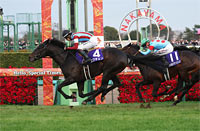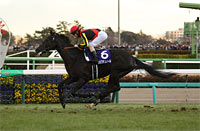Hopeful Stakes (G1) - Data Analysis
G1 race for 2-year-olds that provides direct path to next year’s Classic races
The Hopeful Stakes has been won by a long line of famous runners since the days it was still held as Radio Nikkei Hai Nisai Stakes, a race that was won by runners such as Tokyo Yushun (Japanese Derby) winner Logi Universe, Satsuki Sho (Japanese 2000 Guineas) winner Victoire Pisa, and Kikuka Sho (Japanese St. Leger) winner Epiphaneia. After the race was relocated to Nakayama Racecourse and renamed the Hopeful Stakes, runners such as Tokyo Yushun winner Rey de Oro (2016), Satsuki Sho winner Saturnalia (2018), and Triple Crown winner Contrail (2019) achieved their first G1 victory in this race. Let’s now look for some trends in this race based on data for the four races held since 2017, when the race was upgraded to G1 status.
Race favorites have consistently won the race since it was elevated to G1 status
Since 2017, when the race was upgraded to G1 status, the race has been consistently won by race favorites, while runners backed as 2nd-4th favorite have finished as runners-up. Conversely, only one runner backed as 5th favorite or lower has finished in the Top 3—namely, in 2017. Since 2018, favored runners have continued to dominate the race, producing Trifecta odds of 60 or less. [Table 1]
[Table 1] Performance by favoritism (last four years)
| Favoritism |
Performance
[1st-2nd-3rd-4th or lower] |
Win ratio |
Top 2 ratio |
Top 3 ratio |
| 1st favorite |
4-0-0-0 |
100% |
100% |
100% |
| 2nd favorite |
0-1-1-2 |
0% |
25.0% |
50.0% |
| 3rd favorite |
0-2-1-1 |
0% |
50.0% |
75.0% |
| 4th favorite |
0-1-1-2 |
0% |
25.0% |
50.0% |
| 5th favorite |
0-0-0-4 |
0% |
0% |
0% |
| 6th-9th favorite |
0-0-1-15 |
0% |
0% |
6.3% |
| 10th favorite or lower |
0-0-0-22 |
0% |
0% |
0% |
Focus on runners that have finished in the Top 2 of a graded race or an open-class race
Looking at performances by runners over the last four years in terms of their previous race, we find that nine of the 12 Top 3 finishers had also contested a graded race or an open-class race last time out. Meanwhile, runners coming from newcomer, maiden, or 1-win class races, which collectively made up eight of the nine Top 3 finishers between 2014 and 2016 (when the race was still held as a G2 race), struggled in an apparent sign that the level of the contenders has increased since the race was upgraded to G1 status. In other words, it would seem wise to lower our expectations of runners coming from a race other than a graded race or an open-class race. [Table 2]
[Table 2] Performance by previous race (last four years)
| Previous race |
Performance
[1st-2nd-3rd-4th or lower] |
Win ratio |
Top 2 ratio |
Top 3 ratio |
| Graded race |
3-1-1-11 |
18.8% |
25.0% |
31.3% |
| Open-class race |
1-2-1-5 |
11.1% |
33.3% |
44.4% |
| 1-win class |
0-1-1-13 |
0% |
6.7% |
13.3% |
| Newcomer race |
0-0-1-5 |
0% |
0% |
16.7% |
| Maiden race |
0-0-0-11 |
0% |
0% |
0% |
| NAR race |
0-0-0-1 |
0% |
0% |
0% |
Note: Listed races are included under open-class races.
In addition, 11 of the 12 Top 3 finishers over the last four years entered the race following a victory in their previous race. The exception here was 2017 winner Time Flyer, which entered the race after having finished 2nd in a graded race last time out. Runners that had finished 3rd or lower in their previous race failed to secure a place in the Top 3. In other words, even among runners that have previously contested an open-class race, we should discount those that have finished outside of the Top 2 in that race. [Table 3]
[Table 3] Performance by previous race (last four years)
| Finish in previous race |
Performance
[1st-2nd-3rd-4th or lower] |
Win ratio |
Top 2 ratio |
Top 3 ratio |
| 1st |
3-4-4-27 |
7.9% |
18.4% |
28.9% |
| 2nd |
1-0-0-4 |
20.0% |
20.0% |
20.0% |
| 3rd or lower |
0-0-0-15 |
0% |
0% |
0% |
Focus on jockeys as well
Looking at performances by runners over the last four years in terms of the jockeys, and specifically when comparing the runners ridden by the same jockey as in the previous race with those ridden by a different jockey, we find that the runners in the former group achieved the highest win and Top 3 ratios, and that the latter group was not far behind in terms of the number of Top 3 finishers. However, four of the five Top 3 finishers that were ridden by a different jockey, including 2019 winner Contrail, had been ridden by the same jockey two races back. Runners ridden by a new jockey delivered performance of [0-1-0-21], and achieved a Top 3 ratio of only 4.5%. Among runners ridden by a different jockey from the previous race, we should check if the jockey in question has ridden the horse in the past. [Table 4]
[Table 4] Performance by jockey (last four years)
| Jockey |
Performance
[1st-2nd-3rd-4th or lower] |
Win ratio |
Top 2 ratio |
Top 3 ratio |
| Same jockey as in previous race |
3-1-3-22 |
10.3% |
13.8% |
24.1% |
| Different jockey |
1-3-1-24 |
3.4% |
13.8% |
17.2% |
Solid track record in middle-distance races is essential
Looking at performances in middle-distance races, we find that eight of the 12 Top 3 finishers over the last four years had triumphed in two or more 1,800m+ turf races. These runners consistently dominated the Top 3 in 2019 and 2020, achieving a high Top 3 ratio of 47.1%. The only runner to finish in the Top 3 without having won an 1,800m+ turf race was 2017 runner-up Gendarme. This suggests that we should regard a solid track record in middle-distance races as essential. [Table 5]
[Table 5] Performance by number of wins in 1,800m+ turf races (last four years)
| Number of wins |
Performance
[1st-2nd-3rd-4th or lower] |
Win ratio |
Top 2 ratio |
Top 3 ratio |
| 2 or more |
3-2-3-9 |
17.6% |
29.4% |
47.1% |
| 1 |
1-1-1-29 |
3.1% |
6.3% |
9.4% |
| 0 |
0-1-0-8 |
0% |
11.1% |
11.1% |
Stable horses achieve results
All 12 Top 3 finishers over the last four years had 4 or fewer career starts, and had never been beaten to 3rd or lower. Even though this is a race for 2-year-olds, which have short careers, we should focus on runners that have consistently exhibited strong ability in previous races. [Table 6]
[Table 6] Experience of being beaten to 3rd or lower (last four years)
| Experience |
Performance
[1st-2nd-3rd-4th or lower] |
Win ratio |
Top 2 ratio |
Top 3 ratio |
| Yes |
0-0-0-28 |
0% |
0% |
0% |
| No |
4-4-4-18 |
13.3% |
26.7% |
40.0% |
Seek out the winner!
Focus on runners that have achieved consecutive victories since their debut race
Three of the four last winners (excluding 2017 winner Time Flyer) entered the race undefeated since their debut race. In addition, all four winners, including Time Flyer, had previously won a graded or an open-class 1,800m turf race. When predicting win contenders, we should therefore focus on runners that combine stable performance with a solid track record in middle-distance races. [Table 7]
[Table 7] Winners’ performance through the previous race (last four years)
| Year |
Winner |
Overall record |
Victories in open-class races |
| 2017 |
Time Flyer |
(4 starts, 2 wins) |
Hagi Stakes (turf 1800m) |
| 2018 |
Saturnalia |
(2 starts, 2 wins) |
Hagi Stakes (turf 1800m) |
| 2019 |
Contrail |
(2 starts, 2 wins) |
Tokyo Sports Hai Nisai Stakes (turf 1800m) |
| 2020 |
Danon the Kid |
(2 starts, 2 wins) |
Tokyo Sports Hai Nisai Stakes (turf 1800m) |
(Maya Takanami)
|



















